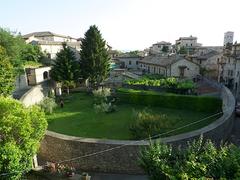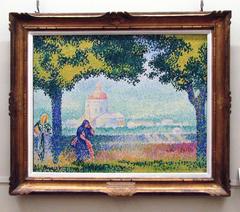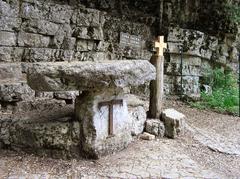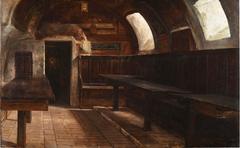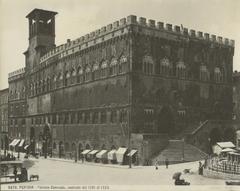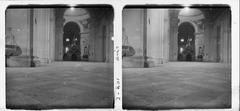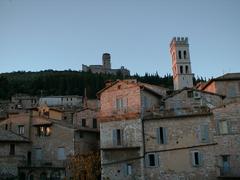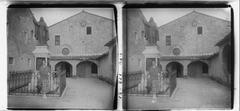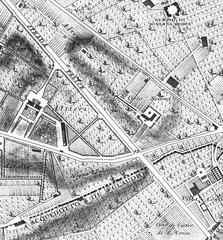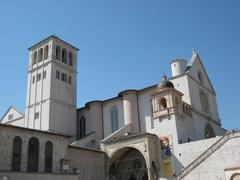Visiting the Cattedrale di San Rufino: Tickets, Hours, and History
Date: 18/07/2024
Introduction
The Cattedrale di San Rufino in Assisi stands as a remarkable blend of historical significance, architectural splendor, and religious reverence. Nestled in the heart of Assisi, this cathedral is a must-visit for history buffs, architecture enthusiasts, and pilgrims seeking a deeper connection with their faith. The cathedral is not only a testament to the town’s rich Christian heritage but also an example of the evolution of architectural styles from Romanesque to Gothic. The cathedral’s history is deeply intertwined with Saint Rufinus, the patron saint of Assisi, whose legacy is immortalized within its walls. This guide offers a comprehensive look at the cathedral’s historical background, architectural marvels, visitor information, and travel tips to enhance your visit to this spiritual and historical landmark (Assisi Online).
Table of Contents
- Introduction
- Historical Background and Architectural Style
- Visitor Information
- Nearby Attractions
- Travel Tips
- Conclusion
- FAQ
- References
Historical Background and Architectural Style
The Cattedrale di San Rufino stands as a testament to Assisi’s rich history and enduring faith. Its story is deeply intertwined with the life of Saint Rufinus, the city’s patron saint, who is believed to have been martyred in the 3rd century AD.
Early Beginnings
The cathedral’s roots reach back to the 8th century when a modest church was erected to house the remains of Saint Rufinus. This early structure served as a vital place of worship for the burgeoning Christian community in Assisi. Over time, as the veneration of Saint Rufinus grew, so too did the desire for a grander, more fitting tribute.
Romanesque Splendor (11th-12th Century)
The 11th century marked a turning point in the cathedral’s history. Under the guidance of Bishop Ugone, a complete reconstruction was undertaken, transforming the humble church into the magnificent Romanesque edifice we see today. The renowned sculptor-architect, Maestro Binello, is credited with leading this ambitious project, which was completed in 1140.
Binello’s vision for San Rufino was one of understated grandeur. The cathedral’s facade, crafted from locally quarried pink and white limestone, embodies the quintessential characteristics of Romanesque architecture. Its design is a harmonious blend of geometric precision and intricate ornamentation.
A Facade Rich in Symbolism
Three rose windows, each with its own unique design, punctuate the facade, symbolizing the Holy Trinity. The central rose window, larger and more elaborate than the flanking two, draws the viewer’s eye upward, emphasizing the cathedral’s spiritual aspirations.
Below the rose windows, a series of blind arches, adorned with delicate carvings of mythical creatures and biblical scenes, add a layer of visual intrigue. These carvings, while aesthetically pleasing, also served a didactic purpose, conveying religious narratives to a largely illiterate populace.
The facade culminates in a triangular pediment, its apex crowned by a statue of Christ flanked by two angels. This iconic composition, a hallmark of Romanesque architecture, reinforces the cathedral’s role as a beacon of faith and a symbol of Christ’s dominion.
Interior Serenity
Stepping inside the Cattedrale di San Rufino is akin to entering a sanctuary of peace and contemplation. The interior, while less ornate than the facade, exudes a sense of serene grandeur. The basilica plan, with its nave and two aisles, creates a sense of spaciousness and light, guiding the visitor’s gaze towards the altar.
Massive cylindrical columns, topped with intricately carved capitals, support the vaulted ceiling, their sheer size a testament to the architectural prowess of the Romanesque era. The play of light and shadow across these columns, particularly during the golden hour, creates an ethereal ambiance, enhancing the spiritual experience.
Artistic Treasures
While the architecture itself is a sight to behold, the Cattedrale di San Rufino also houses a treasure trove of artistic masterpieces. The baptismal font, located in the nave, holds particular significance. It was here that both Saint Francis, Assisi’s beloved son, and Saint Clare, founder of the Order of Poor Clares, were baptized, forever linking their destinies to the cathedral.
The Chapel of the Blessed Sacrament, located to the right of the main altar, is another artistic highlight. Adorned with vibrant frescoes by the 16th-century artist Dono Doni, the chapel showcases the evolution of artistic styles in the centuries following the cathedral’s construction.
Visitor Information
Tickets and Visiting Hours
The Cattedrale di San Rufino is open to visitors daily from 8:00 AM to 7:00 PM. Admission is free, but donations are encouraged to help with the maintenance of the cathedral. For those interested in guided tours, tickets can be purchased at the entrance or online through the official website.
Accessibility
The cathedral is wheelchair accessible, with ramps located at the main entrance. Visitors with mobility issues will find the interior relatively easy to navigate.
Special Events and Services
Throughout the year, the Cattedrale di San Rufino hosts various religious services, concerts, and community events. Check the official website for a calendar of events during your visit.
Nearby Attractions
While in Assisi, be sure to visit other historical sites such as the Basilica of Saint Francis, the Basilica of Saint Clare, and the Rocca Maggiore. Each of these sites offers a unique glimpse into the history and spirituality of this remarkable town.
Travel Tips
- Best Time to Visit - The cathedral is less crowded early in the morning or late in the afternoon.
- Dress Code - Modest attire is required. Shoulders and knees should be covered.
- Photography - Flash photography is not allowed inside the cathedral.
- Local Cuisine - Don’t miss the opportunity to try local dishes at nearby restaurants and cafes.
Conclusion
The Cattedrale di San Rufino stands as a testament to the enduring power of faith and the artistic brilliance of the Romanesque era. Its historical significance, architectural splendor, and artistic treasures continue to captivate visitors from around the globe, offering a glimpse into the soul of Assisi and the enduring legacy of its patron saint. Be sure to add this remarkable site to your itinerary when visiting Assisi.
FAQ
Q - What are the visiting hours for the Cattedrale di San Rufino?
A - The cathedral is open daily from 8:00 AM to 7:00 PM.
Q - Is there an admission fee for the cathedral?
A - Admission is free, but donations are encouraged.
Q - Are guided tours available?
A - Yes, guided tours are available. Tickets can be purchased at the entrance or online.
Q - Is the cathedral wheelchair accessible?
A - Yes, the cathedral is wheelchair accessible.
Q - What other historical sites are nearby?
A - The Basilica of Saint Francis, the Basilica of Saint Clare, and the Rocca Maggiore are nearby attractions worth visiting.
References
- Assisi Online. (n.d.). Cattedrale di San Rufino. Retrieved from https://www.assisionline.it/
- Umbrian Tourism. (n.d.). The Temple of Minerva. Retrieved from https://www.umbriatourism.it/en/the-temple-of-minerva/
